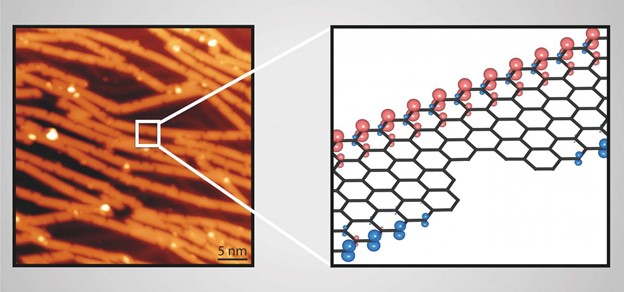
Graphene nanoribbon defects
Graphene nanoribbons (GNRs) feature interesting physical, electrical, thermal, and optical properties because of the interplay between their crystal and electronic structures. These characteristics have pushed them to the forefront in the search for ways to advance next-generation nanotechnologies. Bottom-up fabrication techniques allow the synthesis of a broad range of graphene nanoribbons with well-defined edge geometries, widths, and heteroatom incorporations. However, the question of whether or not structural disorder is present in these atomically precise GNRs, and to what extent, is still subject to debate.
Collaboration between Oleg Yazyev’s Chair of Computational Condensed Matter Physics theory group at EPFL and Roman Fasel’s experimental nanotech@surfaces Laboratory at Empa produced two papers on the topic in armchair-edged and zigzag-edged graphene nanoribbons.
The collaboration focused on characterizing “bite-defects” in graphene nanoribbons and their implications on GNR properties, according to Gabriela Borin Barin from Empa’s nanotech@surfaces lab. These defects can disrupt GNRs’ electronic transport, they could also yield spin-polarized currents. This is important in the context of the potential applications of GNRs in nanoelectronics and quantum technology.
The paper “Quantum electronic transport across “bite” defects in graphene nanoribbons,” published in 2D Materials, looks at 9-atom wide armchair graphene nanoribbons (9-AGNRs). The mechanical robustness, long-term stability under ambient conditions, easy transferability onto target substrates, scalability of fabrication, and suitable band-gap width of these GNRs makes them one of the most promising candidates for integration as active channels in field-effect transistors (FETs). So far, 9-AGNR-FETs display the highest performance.
Schottky barriers, potential energy barriers for electrons formed at metal-semiconductor junctions, both limit the performance of current GNR-FETs and prevent experimental characterization of the impact of defects on device performance. In the 2D Materials paper, researchers combine experimental and theoretical approaches to investigate defects in bottom up AGNRs. The researchers explored the effect of such defects on quantum charge transport, finding that these imperfections significantly disrupt it at the band edges by reducing conductance.
In the paper “Edge disorder in bottom-up zigzag graphene nanoribbons: implications for magnetism and quantum electronic transport,” published in the Journal of Physical Chemistry Letters, the same team of researchers combines scanning probe microscopy experiments and first-principles calculations to examine structural disorder and its effect on magnetism and electronic transport in so-called bottom-up zigzag GNRs (ZGNRs).
The effect of these bite defects on the electronic structure and quantum transport properties of 6-ZGNRs is again examined theoretically. They find that the introduction of the defect, similarly to AGNRs, causes a significant disruption of the conductance. Furthermore, in this nanostructure, these unintentional defects induce sublattice and spin imbalance, causing a local magnetic moment. This gives rise to spin-polarized charge transport that makes defective zigzag nanoribbons optimally suited for applications in all-carbon logic spintronics in the ultimate limit of scalability.
Overall, the research provides a global picture of the impact of these ubiquitous “bite” defects on the low-energy electronic structure of bottom-up graphene nanoribbons. Future research might focus on the investigation of other types of point defects experimentally observed at the edges of such nanoribbons, the researchers said.
Original Release: Eureka Alert
